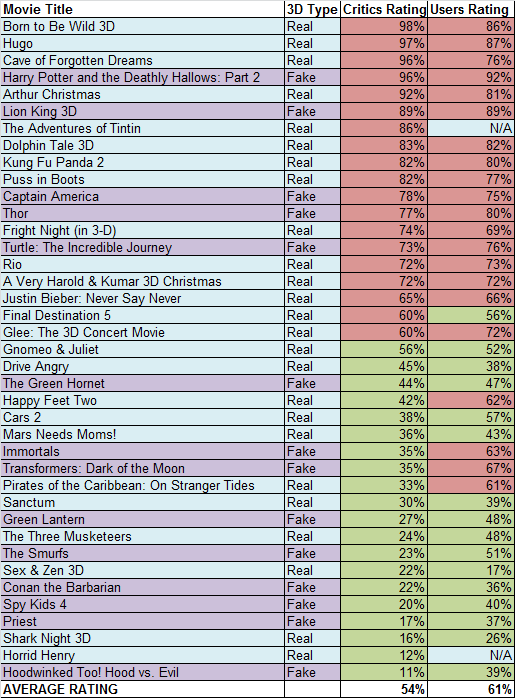Fake 3D Films Score Lower On Rotten Tomatoes, But Only With Critics
As film geeks, we tend to get grumbly about crappy 3D, and no wonder. With the technology adding as much as $4 or $5 to the price of a standard movie ticket, we want to know that when we shell out that extra cash, we'll get our money's worth. And there are movies that put that extra money to good use, Martin Scorsese's Hugo being one recent shining example. Far too often, however, we wind up stuck with bad up-converted 3D that fails to add anything to the experience, or terrible 3D that actively detracts from it. (Ahem, Clash of the Titans.)
But criticizing individual films is one thing; noting actual trends is quite another. Phil Dhingra of RealOrFake3D.com recently looked to RottenTomatoes to see whether viewers actually noticed the difference between good and bad 3D, and found that critics do seem to prefer those shot in 3D. Non-critics, on the other hand, appear to be less discriminating. Check out the results after the jump.
Real 3D movies averaged about 59% with critics on RottenTomatoes, whereas fake ones managed only 46%. "Fake 3D films are contributing to the death of 3D," wrote Dhingra. "There will always be an authenticity gap between real and fake 3D films, and I think moviegoers sense this intuitively."
However, one could argue (and many have argued) that professional movie writers don't represent most moviegoers. Not only do they see way more films than the average audience member, they're professionally obligated to pay much closer attention to things like the quality of the 3D. So, operating under the assumption that RottenTomatoes users are more representative of the movie-watching population than RottenTomatoes critics, I did a little research of my own to see if user scores reflected a similar bias against upconverted 3D — and was surprised to find that the answer was much less conclusive.
Fake 3D movies fared only 2% worse in terms of RottenTomatoes user ratings, with an average score of 60% as opposed to 62% for real 3D. While I must confess to having forgotten how to determine statistical significance — 10th grade AP Statistics was many years ago, so sue me — I suspect a 2% difference in this case doesn't indicate much of anything at all.
Of course, neither my chart nor Dhingra's conclusively proves anything about real vs. fake 3D. There could be any number of other factors at play here, and in any case these figures reflect only 3D films released in 2011. Still, they seem to suggest that while movie critics may appreciate the difference between the two, millions of RottenTomatoes users don't really care.


